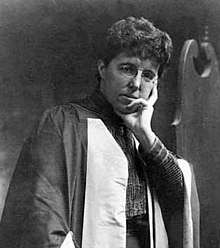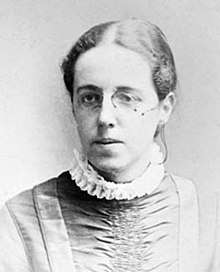Charlotte Scott
Charlotte Angas Scott (8 June 1858, Lincoln, England – 10 November 1931, Cambridge, England) was a British mathematician who made her career in the United States and was influential in the development of American mathematics, including the mathematical education of women. Scott played an important role in Cambridge changing the rules for its famous Mathematical Tripos exam.
Charlotte Scott | |
|---|---|
 Charlotte Angas Scott | |
| Born | 8 June 1858 Lincoln, England |
| Died | 10 November 1931 (aged 73) Cambridge, England |
| Nationality | British |
| Scientific career | |
| Fields | Mathematics |
| Institutions | Cambridge University Bryn Mawr College |
| Doctoral advisor | Arthur Cayley |
| Doctoral students | Louise Cummings Ada Maddison Virginia Ragsdale Emilie Martin |
Early life
She was the second of seven children to Caleb Scott, a minister of the Congregational Church, and Eliza Exley Scott.[1] Educated at Girton College, Cambridge from 1876 to 1880 on a scholarship, she was then a Resident Lecturer in Mathematics there until 1884. In 1885 she became one of the first British woman to receive a doctorate.[2] She did her graduate research under Arthur Cayley at Cambridge University, but since Cambridge did not begin issuing degrees to women until 1948, Scott received her BSc (1882) and D.Sc. (1885) from the University of London[1] through external examinations.
Passing the Tripos
In 1880, Scott obtained special permission to take the Cambridge Mathematical Tripos Exam, as women were not normally allowed to sit for the exam. She came eighth on the Tripos of all students taking them, but due to her sex, the title of "eighth wrangler," a high honour, went officially to a male student.[1]
At the ceremony, however, after the seventh wrangler had been announced, all the students in the audience shouted her name.
The man read out the names and when he came to 'eighth,' before he could say the name, all the undergraduates called out 'Scott of Girton,' and cheered tremendously, shouting her name over and over again with tremendous cheers and waving of hats.
— contemporary report, "Charlotte Angas Scott (1858–1931)" in Women of Mathematics: A Biobibliographic Sourcebook[1]
Because she could not attend the award ceremony, Scott celebrated her accomplishment at Girton College where there were cheers and clapping at dinner, a special evening ceremony where the students sang "See the Conquering Hero Comes", received an ode written by a staff member, and was crowned with laurels.[1]
After this incident women were allowed to formally take the exam and their exam scores listed, although separately from the men's and thus not included in the rankings. Women obtaining the necessary score also received a special certificate instead of the BA degree with honours. In 1922, James Harkness remarked that Scott's achievement marked "the turning point in England from the theoretical feminism of Mill and others to the practical education and political advances of the present time".[1]
Work

Moving to the United States in 1885, she became one of eight founding faculty and Associate Professor of Mathematics at Bryn Mawr College, and Professor from 1888 to 1917. She was the first mathematician at Bryn Mawr College and the first department head.[2] During this period she directed the PhD theses of many pioneering women mathematicians.[3] Of the nine women to earn doctorates in mathematics in the nineteenth century, three studied with Scott.[1]
Her mathematical speciality was the study of specific algebraic curves of degree higher than two.[4] Her book An Introductory Account of Certain Modern Ideas and Methods in Plane Analytical Geometry was published in 1894 and reprinted thirty years later. Scott was one of the first English language textbook writers to be "perfectly aware" of the "distinction between a general principle and a particular example". She played an important role in the transition to twentieth century custom of abstract mathematical proofs.[1]
In 1891 she became the first woman to join the New York Mathematical Society, which later became the American Mathematical Society.[3] She served as the first woman on the first Council of the American Mathematical Society in 1894, and received an acclaimed review from the Society in 1896.[2] She is also credited with being the author of the first mathematical research paper written in the US to be widely recognised in Europe, "A Proof of Noether's Fundamental Theorem".[2][5] She was one of only four women to attend the inaugural International Congress of Mathematicians in Zurich in 1897; the other three were Iginia Massarini, Vera von Schiff, and Charlotte Wedell.[6] In 1906 Scott served as Vice-President of the American Mathematical Society.
Women in mathematics
Scott maintained the view that personal conservatism was a requirement to promote women's educational and political equality. She disapproved of smoking and makeup, however she did bob her hair before moving to Bryn Mawr (short hair being controversial even in the 1920s). This view was also held by the early Girton College community, because unaccompanied women in Cambridge could be thrown into Spinning House, a special prison for prostitutes and suspected prostitutes.[1]
She was a staunch supporter of rigour in women's classes, writing in a letter to Bryn Mawr President M. Carey Thomas:
I am most disturbed and disappointed at present to find you taking the position that intellectual pursuits must be "watered down" to make them suitable for women, and that a lower standard must be adopted at a woman's college than in a man's. I do not expect any of the other members of the faculty to feel this way about it; they, like (nearly) all men that I have known, doubtless take an attitude of toleration, half amused and half kindly, on the whole question; for even where men are willing to help in women's education, it is with an inward reserve of condescension.
— Charlotte Scott, Scott Papers[1]
The word "nearly" written in small lettering above the handwritten letter.[1]
Later life
In 1906 Scott developed an acute case of rheumatoid arthritis, which along with her increasing deafness, interrupted her work. Under the advice of a doctor to get outside exercise, Scott began gardening and developed a new strain of chrysanthemum. She retired in 1924, but stayed an extra year in Bryn Mawr to help her eighth doctoral student complete her dissertation before she returned to and settled in Cambridge.[1]
She died on the 10 November 1931 and buried at the Parish of the Ascension Burial Ground in Cambridge, in her cousin Eliza Nevin's grave.[7]
Now walk to the door of the chapel and look at grave 4C52 which is a curb in the second row in the second row on your right. There is a scroll on this grave of ELIZA NEVIN to CHARLOTTE ANGUS SCOTT, who entered Girton College in 1876 and became a Wrangler in the Mathematical Tripos in 1880.
— L.J. Slater, A Walk Around The Ascension Parish Burial Ground
Recognition
In 2016 the Council of the University of Cambridge approved the use of Scott's name to mark a physical feature within the North West Cambridge Development.[8]
Publications
- Scott, Charlotte A. (1894). An Introductory Account of Certain Modern Ideas and Methods in Plane Analytical Geometry. Macmillan.
Citations
- Patricia Clark Kenschaft (1987). "Charlotte Angas Scott (1858–1931)" in Women of Mathematics: A Biobibliographic Sourcebook. New York: Greenwood Press. pp. 193–203. ISBN 0-313-24849-4.
- Chaplin, Stephanie (1997). "Biographies of Women Mathematicians: Charlotte Angas Scott". Agnes Scott College. Retrieved 22 October 2012.
- Duren, Peter L.; Askey, Richard; Merzbach, Uta C. (1992). A Century of Mathematics in America. American Mathematical Society. p. 382. ISBN 0821801384.
- Kenschaft, Patricia (1977). "Charlotte Angas Scott" (PDF). AWM Newsletter. 7 (6): 11–12.
- Scott, Charlotte Angas (1 December 1899). "A proof of Noether's fundamental theorem". Mathematische Annalen. 52 (4): 593–597. doi:10.1007/BF01453778.
- Curbera, Guillermo (2009), Mathematicians of the World, Unite!: The International Congress of Mathematicians--A Human Endeavor, CRC Press, p. 16, ISBN 9781439865125
- Goldie, Dr. Mark (2009). A Guide to Churchill College, Cambridge. pp. 62–63.
- Administrator (29 January 2015). "Street Naming". www.nwcambridge.co.uk. Retrieved 8 March 2017.
References
- Green, Dr. Judy (29 June 2000). "How many women mathematicians can you name?" (PDF). Summer Undergraduate Mathematical Sciences Research Institute / Miami University. Archived from the original (PDF) on 20 February 2012. Retrieved 21 October 2012.
- Girton College Register 1869–1946, University Press, Cambridge, 1948
- Eaton, Shelby L. (21 August 1997). "Women in Mathematics in the United States: 1866–1900". Shelby L. Eaton. Archived from the original on 16 March 2012. Retrieved 21 October 2012.
External links
- Charlotte Scott at Find a Grave
- Charlotte Scott at the Mathematics Genealogy Project
- "Charlotte Agnas Scott" written by Isabel Maddison
- Digital Copy of "Charlotte Angas Scott (1858–1931)" in Women of Mathematics: A Biobibliographic Sourcebook by Patricia Clark Kenschaft